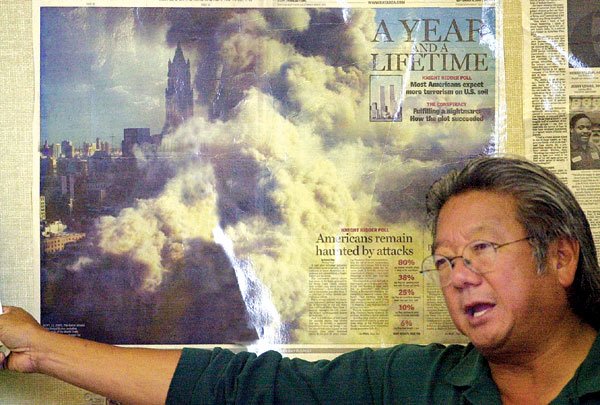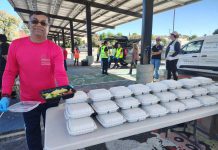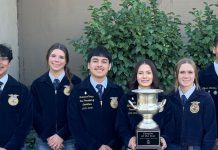GILROY
– Each generation is said to have a defining moment. Many Gilroy
teachers believe Sept. 11, 2001, will be that moment for the city’s
school-aged children.
By Lori Stuenkel
GILROY – Each generation is said to have a defining moment. Many Gilroy teachers believe Sept. 11, 2001, will be that moment for the city’s school-aged children.
Before the second anniversary of the terrorist attacks, teachers were deciding how and whether to broach the subject with students. Those who decided to talk about the subject found creative ways to connect with students about their fears and tie the attacks into broader classroom themes.
Kabo Orimoto’s social studies class learned about two other important dates in history and linked them to Sept. 11.
“The message is always: You will never forget where you were when you heard about Dec. 7, Nov. 22, or Sept. 11,” Orimoto told his class of seventh- and eighth-graders at South Valley Middle School.
Orimoto used various media to show his students that the attack on Pearl Harbor in 1941 and the assassination of President John F. Kennedy in 1963 affected the American public much like Sept. 11 did two years ago. Orimoto thought students would be interested in seeing video clips from Pearl Harbor and Kennedy’s assassination, because most of them watched the news constantly in the weeks after Sept. 11, he said.
The video clips featured coverage of Pearl Harbor, including a portion of President Roosevelt’s speech calling Dec. 7 “a date which will live in infamy.” Students also watched portions of President Kennedy’s last day and watched him recite those famous words: “Ask not what your country can do for you; ask what you can do for your country.”
Many students were seeing the images for the first time. The students related to America’s reaction, wondering what time of day Kennedy was killed, learning that few people in 1941 even knew where Hawaii was, pondering what it would be like to learn of the death of the president.
The students also listened to songs expressing the country’s mix of hurt and resolve. Orimoto played the songs, including Alan Jackson’s “Where were you (when the world stopped turning)” last September and again Thursday because they helped students relate to history, Orimoto said.
“When I played the Alan Jackson song, the kids wanted to hear it again,” he said. “They were really touched by this song.”
Most students wanted to discuss the Sept. 11 attacks, whether or not the topic directly related to classroom lessons.
“I like that students are reminded of what happened,” said Regina Lopez, an eighth-grader at South Valley. “Everybody is so busy with their lives that they forget what happened, and I think it’s important to remember.”
In Sharon Avina’s eighth-grade language arts and social studies class, students tied Sept. 11 experiences into their studies of sentence structure. They researched the library and the Internet to find quotes relating to Sept. 11 that matched four types of sentences the class has been studying. Avina hoped students would reflect on both sentence structure and how the World Trade Center attacks changed people’s lives.
“The idea I’m trying to get across and also get from them is pride: pride in being American, pride in being resilient, courage in meeting these terrible times,” Avina said. “Just as my mother’s generation had Dec. 7 and my generation had Vietnam, well, who knows what this means for these kids. So they have to understand that as American people we stay together.”
At Gilroy High School, global studies and government teacher Kanani Pratt related Sept. 11 to current events, particularly the rebuilding of Afghanistan and the occupation of Iraq, rather than reflecting on the attacks themselves.
“(Students are) interested in what’s going on in Iraq. … I don’t think they always make the connection to Sept. 11 and that that’s why we’re oversees,” Pratt said. “We make the connection to Sept. 11 for students, but we don’t make an overall theme of Sept. 11 throughout our curriculum.”
In her government class, Pratt’s students focused on Sept. 11’s affects on American liberties, including increased airport security, fear of additional terrorist attacks and the Patriot Act’s swift adoption, she said.
“We are talking about the Patriot Act now … what exactly it means and the infringement of our First Amendment rights,” she said. “For good or bad, it’s still very controversial as far as government is concerned.”
Pratt applied her global studies theme of tolerance to Sept. 11 and Islamic terrorists, encouraging students to look beyond stereotypes.
“We look at all the major religions in the world, and as we look at those religions, we talk about the stereotypes that go along with them,” Pratt said. “They appreciate and understand cultural differences, diversity and acceptance.”
Students at GHS used Thursday to show their appreciation for Gilroy’s emergency responders. Associated Student Body leaders hosted a reception from 8 a.m. to 1:30 p.m. in the courtyard of the administration building, offering a certificate of thanks to each of the officers and firefighters who attended. The ASB displayed media coverage from the months following Sept. 11, and students stopped by to sign a large banner to express their thanks.
“Kids wrote some nice things on there, like they were thankful for the firefighters,” said Jennifer Clet, ASB spirit head. Her father, Jeff, is Gilroy’s fire chief. “By the end of the day there were a lot of signatures on the poster.”
Clet estimated the poster was 4 by 10 feet in size.
ASB President Raquel Lucente, a senior, said the poster will be laminated and displayed in the school’s activities office. She said the reception was attended by 25 to 30 emergency personnel, including firefighters, police and highway patrol officers and military personnel.
Schools across Gilroy flew flags at half-staff and most observed a moment of silence Thursday morning to remember those who died in the terrorist attacks. Some teachers and staff were commemorating the day quietly, wearing red, white and blue or American flag pins.
Most elementary schools in Gilroy chose to focus on social studies lessons that paralleled state standards rather than take time out to discuss Sept. 11 with students.
El Portal Leadership Academy teacher Ted Curran concentrated his Sept. 11 lesson on how circumstances can change people.
His 11th-grade English class is currently studying a Native American novel that tells the story of a tribe whose culture changed as it was forced to move about the country.
“Kids were saying that they turned on (the TV Sept. 11) and thought it was a movie,” Curran said. “We’re used to seeing things like that and have it be fake. … In Jerusalem, they see that and it’s real.”















